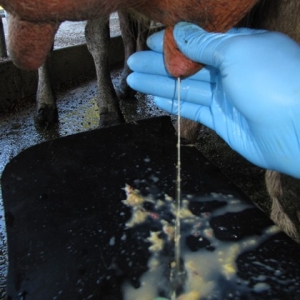However, a review of advertising practices is planned "to determine if additional guidance is needed or if the existing controls on advertising need to be changed for antibiotic veterinary medicines."
MPI says the report, Antibiotics Sales Analysis 2009-2011, found a 19% reduction in antibiotic use over the three years surveyed.
"We understand that this reduction is largely attributable to positive changes in production animal management in the pig, poultry and dairy industries," says MPI deputy director-general standards, Carol Barnao.
"These industries have reported a move towards non-antibiotic preventative treatments like vaccination and changes to on-farm practices to decrease their antibiotic use."
DairyNZ and the Dairy Companies Association of New Zealand (DCANZ) say the report highlights the importance of animal owners working with veterinarians to manage antibiotic use.
"Ensuring [antibiotics'] future effectiveness is in everyone's interest," says DCANZ executive office Kimberly Crewther.
"The dairy industry's position on antibiotic use is to use as little as possible without compromising animal welfare.... Prevention is the best approach.... This is especially the case for the key areas of lameness and mastitis."
DairyNZ chief scientist Dr Eric Hillerton says all dairy antibiotic treatments are recorded and records of use are independently audited annually by processors to manage milk quality risks and ensure only healthy animals contribute to milk supply.
"The national mastitis control programmes developed and implemented by DairyNZ and industry partners ensure the quality of milk supplied from farms is world leading," he says, noting New Zealand has only half the mastitis of the USA and a quarter of the UK incidence.
DairyNZ worked with the International Dairy Federation to produce a guide to prudent use of antimicrobial agents in dairy production and it is being customised for New Zealand, says Hillerton.
Crewther says the dairy industry is "committed to sensible and expedient use of antibiotics to safeguard animal health and welfare, and ensure a safe product for consumers."
MPI says considerable consultation with industry and selected individual veterinarians went into the report's compilation which is why it is two years out of date, says MPI. However, having established procedures for such a report the next one, covering 2011-2013, should be released June 2014. Thereafter, reports will be released annually.
Barnao says the 2009-11 analysis revealed areas needing further study, including increased use of injectable tylosin in cattle, third and fourth generation cephalosporins in production and companion animals, and reported marketing and choice of antibiotics based on convenience rather than most appropriate therapeutic choice.
"As a result of this information, MPI will gather further information and look at controls around the marketing and use of antibiotic products to determine they effectively manage risks associated with antibiotic resistance," says Barnao.
Tylosin use is important because it is in the class of antibiotics known as Macrolides, a class important to human medicine. A trend of increased use in cattle as a convenient once-daily treatment for mastitis needs investigating to ensure the potential risk of antibiotic resistance is limited, and it is the most appropriate treatment. It is critical to the management of certain infections not responsive to other antibiotics, says MPI.
Other convenience factors which could be compromising use and MPI intends to investigate include zero or short withholding periods, and "one shot dose" products.
New Zealand's use of antibiotics and resistance status was surveyed by MPI in a baseline study covering 2009-10. It found farm use to be responsible and in compliance with veterinarian advice, and what little resistance was found had no direct implications for human health. There did not appear to have been an increase in resistance since previous studies, and compared with 2009 data from Denmark resistance among bacteria from New Zealand pigs and poultry was either lower or not significantly different.
MPI says control of use of veterinary antibiotics in New Zealand meets international best practice but the latest report provides some opportunities to verify practices and further refine controls if needed.
The New Zealand Veterinary Association and industry groups such as NZ Pork and the Poultry Industry Association New Zealand (PIANZ) have published guidance for the prudent use of antibiotics within industry. Further guidance and updates from NZVA are in progress.
The MPI report is at http://www.mpi.govt.nz/Default.aspx?TabId=126&id=2121
A MINISTRY for Primary Industry report released today says veterinary and horticultural antibiotic use appears to be dropping.
Popular Reads
Dawn Meats confirms no Alliance plant closures
The new majority owner of meat company Alliance has no plans to close any processing plants. Instead, Dawn Meats plans…Waituna Lagoon consent puts farms at risk, Federated Farmers Say
According to Federated Farmers, Environment Southland has mishandled the consent process for Waituna Lagoon, leaving the community with numerous bad…New target 'political theatre'
OPINION: Farmers are being asked to celebrate a target that changes nothing for the climate, wastes taxpayer money, and ignores…Pamu backs Fonterra’s $4.22B divestment as shareholders deliver strong ‘yes’ vote
One of Fonterra's largest milk suppliers says Fonterra's board and management have got what they wanted - a great turnout…Featured
Editorial: Local govt overhaul
OPINION: The latest reforms of local government should come as no surprise.
Export delays, weather and global supply pressure hit NZ avocado growers
The avocado industry is facing an extremely challenging season with all parts of the supply chain, especially growers, being warned to prepare for any eventuality.
Government approves nationwide recycling scheme for primary sector plastics
Rural recycling scheme Agrecovery is welcoming the Government's approval of regulations for a nationwide rural recycling scheme for agrichemicals and farm plastics.
Late start but strong season ahead for New Zealand strawberries
Despite a late and unfavourable start, this year’s strawberry crop is expected to be bountiful for producer and consumer alike.
Hawke’s Bay growers still rebuilding three years after Cyclone Gabrielle
Nearly three years on from Cyclone Gabrielle, Hawke's Bay apple orchardist Paul Paynter says they are still doing remedial work around their orchards and facing financial challenges.
EU Ambassador highlights value of Geographical Indications for NZ producers
An unusual participant at the recent Royal A&P Show in Christchurch was a stand promoting a variety of European products, during an event that normally champions the homegrown.
National
NZ Local Government Reform: Regional councils axed, CTBs proposed
The biggest reform of local government in more than 35 years is underway.MPI launches industry-wide project to manage feral deer
An industry-wide project led by Ministry for Primary Industries (MPI) is underway to deal with the rising number of feral…US tariffs and shipping delays push NZ apple exports to Asia
A Hawke's Bay apple grower says it's no longer profitable for him to export apples to the US because of…Farmers warned to upgrade as 3G shutdown looms
As the clock ticks towards the 3G mobile network shutdown, farmers are being warned to upgrade or risk losing connection…Dawn Meats takes 65% stake in Alliance Group in major industry deal
Alliance and Dawn Meats have completed their new strategic partnership.Machinery & Products
2026 Toyota RAV4 NZ: New line-up, first PHEV & upgraded hybrids
Over the years, the RAV4 has proven to be a vehicle that appeals to all markets, taking the number one…Farmer’s tractor order delivers an extra set of wheels
With life often a matter of timing, complemented by a portion of luck, it looks like Waikato farmer Matthew Darke’s…AgriSIMA 2026 Paris machinery show cancelled
With the current situation in the European farm machinery market being described as difficult at best, it’s perhaps no surprise…WA tractor museum honours Oliver Crane’s legacy
Located in York, 100km east of Perth in Western Australia, the Oliver Crane Memorial 4×4 Tractor Museum houses what is…Krone unveils new CombiPack HDP baler and halts US exports
Well-known for an extensive range of round balers, Krone’s new CombiPack HDP looks to have several features that sets it…» Latest Print Issues Online
The Hound

Badge of honour!
OPINION: This old mutt thinks New Zealand should take a bow after winning the ‘Fossil of the Day’ award at COP30…
A hungry world
OPINION: The Hound reckons the argument run by the ‘agribusiness elite’ that the market will punish our exports if we don’t…
















